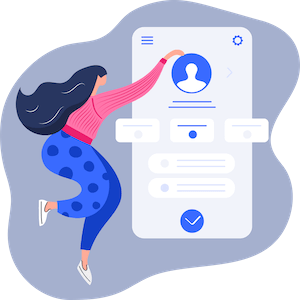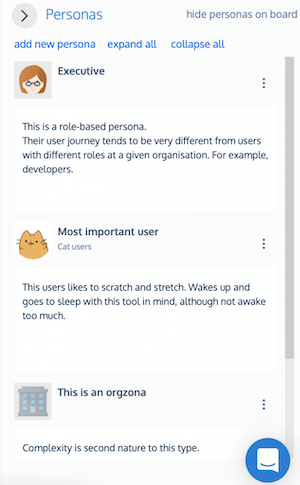User persona design has long been a constant in product development to help development teams empathize with users. Understanding users’ needs wants and journeys is key to creating great products, but it can also be the hardest part.
Agile teams can easily lose focus on user journeys and tend to focus on story points. This is when the role of the Product Manager becomes really important, it is their job to ensure that a user-centric approach is maintained by using user personas to map user stories.
In the literature on user persona design, you will often only find basic templates and clichés. So where can you look for more advanced techniques?
UI/UX Designers are usually experts in the subject, so it’s worth turning to them for ideas. This is also what we did for this blog post. Here’s what we’ve found out:
Contents
Types of User Personas in Story Mapping
Not all user personas are created in the same way. UI/UX designers identify 4 different types based on the purpose and the amount of previous research done. None is the ultimate target type, but all may be needed at different stages of product development.
Goal-directed Personas
The descriptions of goal-oriented user personas are extremely to the point. They answer one simple question: what does the user want to achieve with this product? Goal-oriented personas are usually short descriptions that rely mainly on facts.
This type is recommended if you have done a lot of research on your users and know them very well. This type does not generate empathy on its own, so teams that can fill in the blanks will benefit the most.
Role-based Personas
Role-based personas are based on the role that a particular user plays within the organization. For example, leaders and managers will use tools differently than, say, the development team. Therefore they usually need a different user persona.
Engaging Personas
By using the best of both approaches above, you can design user personas truly engaging.
The aim is to create a persona that is very real to the whole team so that as many of them as possible can relate to it. Engaging personas need to be created with the user’s emotions and psychology in mind, and you also need to know something about their background to understand their goals more deeply. Engaging personas are most helpful in evoking empathy,
Fictional Personas
Fictitious personas are based on assumptions about users’ past experiences. When a design team hypothesizes what a particular persona may or may not want to achieve, they are called fictional personas.
Remember that these types of personas can be very misleading and should always be carefully researched before using them in user story maps. As Jeff Patton points out, “You are not your user”. Let’s not fall into the trap of self-replacement.
Expert Tips from UI/UX Designers

Don’t Just Ask Users What They Want – Rely on Data to Design User Personas
A good persona is built from sound data, not from mindless brainstorming. Many development teams make the mistake of asking users what features they want to see in a product and simply following their wishes.
Where does it lead?
Without a clear understanding of your users, you’ll likely find yourself in a feature competition and lose (or never reach) your competitive advantage. Users are not experts in UX research and often do not see the big picture.
Through the user persona design process, be sure to rely on data and try to eliminate the guesswork as much as possible.
What Can be Considered as Research?
Research does not have to be super-scientific. Talking to users and observing how they use the product is already very valuable research. Make sure that you always include user observation in the research phase, or it is best to do it continuously.
User persona research and user persona design should always precede user story mapping. Vague statements should follow careful research, not precede them.
How Many User Personas Should We Have on a Story Map?

Prioritization is also king when it comes to the number of user personas.
You need to have a fixed number in mind when deciding on how many personas you’ll want to build for a single-user story map.
After brainstorming all the user persona types that use your product, rank them from most to least critical. Each persona should have a good reason why it should be included, if it doesn’t influence the final design, leave it out.
A typical software product will have between 3 to 10 personas, a good story map should have fewer than that. However, when mapping user stories, you must always focus on a single user persona otherwise you will want to meet all the requirements of all personas, which is impossible.
How Does User Persona Design Help with Prioritization and Release Planning?
Give the best possible experience to your user persona design in focus. Especially, when you’re building an MVP, you don’t have the luxury of including all possible users. As we’ve mentioned before, prioritization is king.
Walking through each user persona on the story map and identifying individual user stories and gaps in the story map is key. Still, you’ll have to be able to prioritize user stories that will need to be included in the MVP.
What Happens When Your Personas are Organizations?
Organizational profiles can also work as personas. Jeff Patton calls these “orgzonas”. These personas tend to be much more “fact-heavy” and have fewer fictional elements.
Research is more complex because the users and the decision-makers are not the same people. Even if you design the product with the user in mind, you need to take other stakeholders into account.
Find the Balance Between Facts and Fiction
Fictional details can be very helpful, but if you overdo them, it’ll lead to fictional personas. Rely on facts of thorough persona research and only fill in the ‘blanks’ with fiction such as likes and dislikes, and hobbies of a character. These small details will help your team put themselves in the persona’s shoes, but won’t lead them to false conclusions.
How To Build User Personas in StoriesOnBoard that will help you to Create a Great Product?

StoriesOnBoard supports the pragmatic user persona design approach used by most agile teams.
For all types of user personas identified as critical, pick a custom icon that best describes them and fill in their profiles. You can create persona groups based on job roles, archetypes, etc.
In the StoriesOnBoard app, you can add personas to epics and individual story cards to map user journeys and potentially identify gaps in user stories more easily.
StoriesOnBoard Tip: One Persona per User Journey
Assigning a new persona to every different user journey can be a good idea if you have multiple user journeys such as “impulse shopper”, “researcher”, “discount chaser”, “fashionable diva” or “last minute shopper”. This way you’ll use personas to map individual user journeys on your user story map. Identifying user journeys becomes significantly easier if you can filter them by personas.

